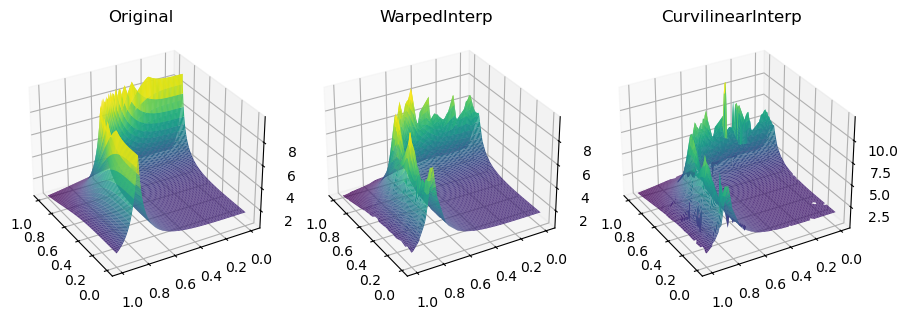This notebook uses examples from scipy documentation to demonstrate HARK’s Warped2DInterp class.
from __future__ import annotations
from time import time
import matplotlib.pyplot as plt
import numpy as np
from HARK.interpolation import Curvilinear2DInterp
from multinterp.curvilinear import Warped2DInterpSuppose we have a collection of values for an unknown function along with their respective coordinate points. For illustration, assume the values come from the following function:
def function_1(x, y):
return x * (1 - x) * np.cos(4 * np.pi * x) * np.sin(4 * np.pi * y**2) ** 2The points are randomly scattered in the unit square and therefore have no regular structure.
rng = np.random.default_rng(0)
warp_factor = 0.01
x_list = np.linspace(0, 1, 20)
y_list = np.linspace(0, 1, 20)
x_temp, y_temp = np.meshgrid(x_list, y_list, indexing="ij")
rand_x = x_temp + warp_factor * (rng.random((x_list.size, y_list.size)) - 0.5)
rand_y = y_temp + warp_factor * (rng.random((x_list.size, y_list.size)) - 0.5)
values = function_1(rand_x, rand_y)Now suppose we would like to interpolate this function on a rectilinear grid, which is known as “regridding”.
grid_x, grid_y = np.meshgrid(
np.linspace(0, 1, 100), np.linspace(0, 1, 100), indexing="ij"
)To do this, we use HARK’s Warped2DInterp class. The class takes the following arguments:
values: an ND-array of values for the function at the pointsgrids: a list of ND-arrays of coordinates for the pointsmethod: the interpolation method to use, with options WarpedInterp, “linear”, “cubic” (for 2D only), and “rbf”. The default is'linear'.
warped_interp = Warped2DInterp(values, (rand_x, rand_y), backend="numba")
warped_interp.warmup()Once we create the interpolator objects, we can use them using the __call__ method which takes as many arguments as there are dimensions.
start = time()
warped_grid = warped_interp(grid_x, grid_y)
print(f"Warped interpolation took {time() - start:.5f} seconds")Warped interpolation took 0.00253 seconds
curvilinear_interp = Curvilinear2DInterp(values, rand_x, rand_y)
start = time()
curvilinear_grid = curvilinear_interp(grid_x, grid_y)
print(f"Curvilinear interpolation took {time() - start:.5f} seconds")Curvilinear interpolation took 0.01309 seconds
Now we can compare the results of the interpolation with the original function. Below we plot the original function and the sample points that are known.
plt.imshow(function_1(grid_x, grid_y).T, extent=(0, 1, 0, 1), origin="lower")
plt.plot(rand_x.flat, rand_y.flat, "ok", ms=2, label="input points")
plt.title("Original")
plt.legend(loc="lower right")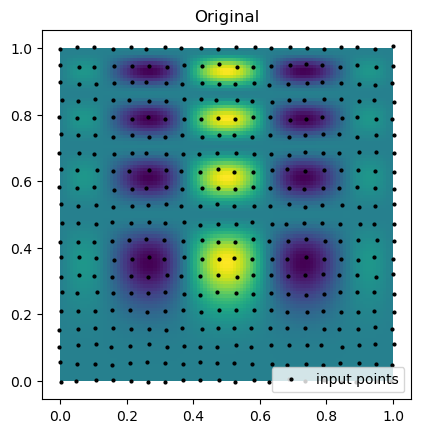
Then, we can look at the result for each method of interpolation and compare it to the original function.
fig, axs = plt.subplots(1, 3, figsize=(9, 6))
titles = ["Original", "WarpedInterp", "CurvilinearInterp"]
grids = [function_1(grid_x, grid_y), warped_grid, curvilinear_grid]
for ax, title, grid in zip(axs.flat, titles, grids):
im = ax.imshow(grid.T, extent=(0, 1, 0, 1), origin="lower")
ax.set_title(title)
plt.tight_layout()
plt.show()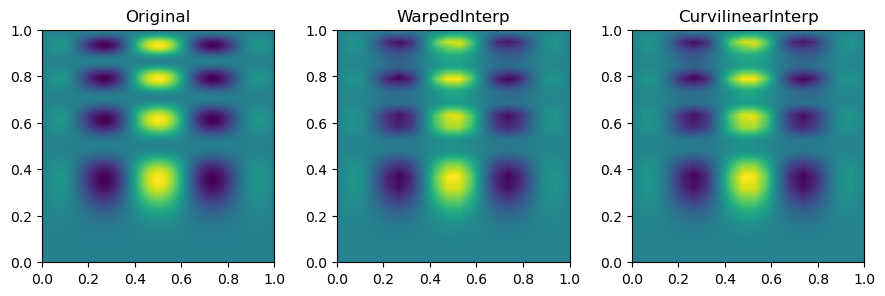
Another Example¶
def function_2(x, y):
return np.hypot(x, y)rng = np.random.default_rng(0)
warp_factor = 0.05
x_list = np.linspace(-0.5, 0.5, 10)
y_list = np.linspace(-0.5, 0.5, 10)
x_temp, y_temp = np.meshgrid(x_list, y_list, indexing="ij")
rand_x = x_temp + warp_factor * (rng.random((x_list.size, y_list.size)) - 0.5)
rand_y = y_temp + warp_factor * (rng.random((x_list.size, y_list.size)) - 0.5)
values = function_2(rand_x, rand_y)grid_x, grid_y = np.meshgrid(
np.linspace(-0.5, 0.5, 100), np.linspace(-0.5, 0.5, 100), indexing="ij"
)warped_interp = Warped2DInterp(values, (rand_x, rand_y), backend="numba")
start = time()
warped_grid = warped_interp(grid_x, grid_y)
print(f"Warped interpolation took {time() - start:.5f} seconds")Warped interpolation took 0.00100 seconds
curvilinear_interp = Curvilinear2DInterp(values, rand_x, rand_y)
start = time()
curvilinear_grid = curvilinear_interp(grid_x, grid_y)
print(f"Curvilinear interpolation took {time() - start:.5f} seconds")Curvilinear interpolation took 0.00652 seconds
plt.imshow(function_2(grid_x, grid_y), extent=(-0.5, 0.5, -0.5, 0.5), origin="lower")
plt.plot(rand_x.flat, rand_y.flat, "ok", ms=2, label="input points")
plt.title("Original")
plt.legend(loc="lower right")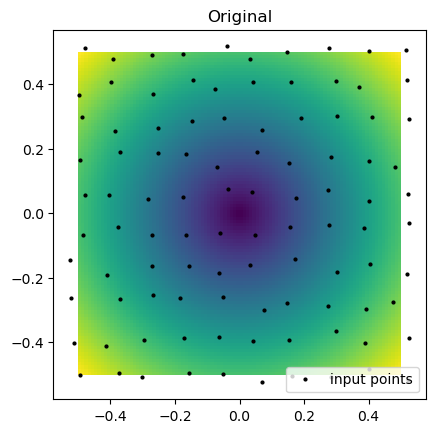
fig, axs = plt.subplots(1, 3, figsize=(10, 3))
titles = ["Original", "WarpedInterp", "CurvilinearInterp"]
grids = [function_2(grid_x, grid_y), warped_grid, curvilinear_grid]
for _i, (ax, title, grid) in enumerate(zip(axs.flat, titles, grids)):
im = ax.pcolormesh(grid_x, grid_y, grid, shading="auto")
ax.set_title(title)
cbar = fig.colorbar(im, ax=axs)
for ax in axs.flat:
ax.axis("equal")
plt.show()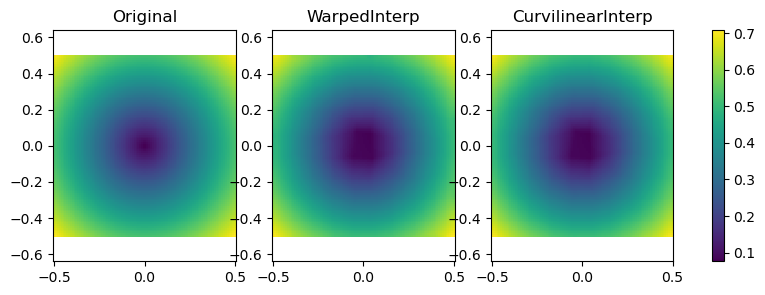
Unstructured Interpolators with Curvilinear Grids¶
def function_3(u, v):
return u * np.cos(u * v) + v * np.sin(u * v)rng = np.random.default_rng(0)
warp_factor = 0.1
x_list = np.linspace(0, 3, 10)
y_list = np.linspace(0, 3, 10)
x_temp, y_temp = np.meshgrid(x_list, y_list, indexing="ij")
rand_x = x_temp + warp_factor * (rng.random((x_list.size, y_list.size)) - 0.5)
rand_y = y_temp + warp_factor * (rng.random((x_list.size, y_list.size)) - 0.5)
values = function_3(rand_x, rand_y)grid_x, grid_y = np.meshgrid(
np.linspace(0, 3, 100), np.linspace(0, 3, 100), indexing="ij"
)warped_interp = Warped2DInterp(values, (rand_x, rand_y), backend="numba")start = time()
warped_grid = warped_interp(grid_x, grid_y)
print(f"Warped interpolation took {time() - start:.5f} seconds")Warped interpolation took 0.00100 seconds
curvilinear_interp = Curvilinear2DInterp(values, rand_x, rand_y)
start = time()
curvilinear_grid = curvilinear_interp(grid_x, grid_y)
print(f"Curvilinear interpolation took {time() - start:.5f} seconds")Curvilinear interpolation took 0.00704 seconds
plt.imshow(function_3(grid_x, grid_y).T, extent=(0, 3, 0, 3), origin="lower")
plt.plot(rand_x.flat, rand_y.flat, "ok", ms=2)
plt.title("Original")
plt.legend(loc="lower right")No artists with labels found to put in legend. Note that artists whose label start with an underscore are ignored when legend() is called with no argument.
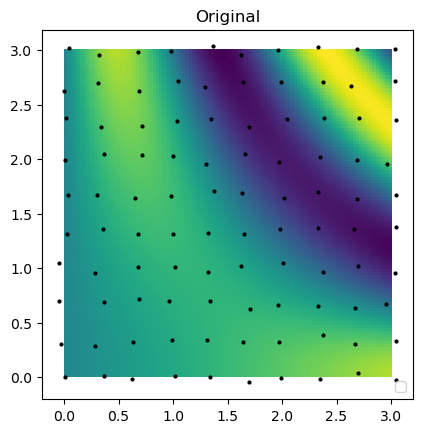
fig, axs = plt.subplots(1, 3, figsize=(9, 3))
titles = ["Original", "WarpedInterp", "CurvilinearInterp"]
grids = [function_3(grid_x, grid_y), warped_grid, curvilinear_grid]
for ax, title, grid in zip(axs.flat, titles, grids):
im = ax.imshow(grid, extent=(0, 3, 0, 3), origin="lower")
ax.set_title(title)
plt.tight_layout()
plt.show()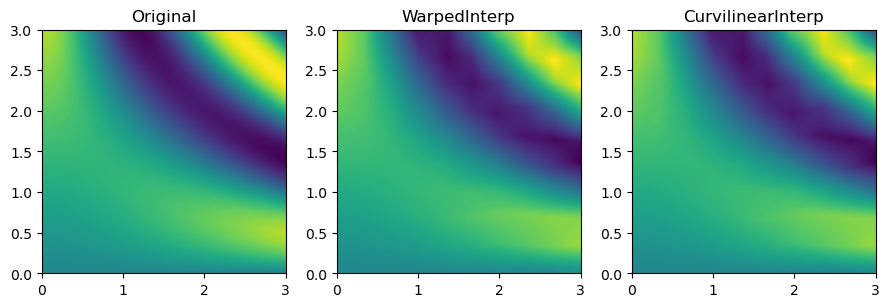
def function_4(x, y):
return 3.0 * x**2.0 + x * y + 4.0 * y**2.0rng = np.random.default_rng(0)
warp_factor = 0.2
x_list = np.linspace(0, 5, 10)
y_list = np.linspace(0, 5, 10)
x_temp, y_temp = np.meshgrid(x_list, y_list, indexing="ij")
rand_x = x_temp + warp_factor * (rng.random((x_list.size, y_list.size)) - 0.5)
rand_y = y_temp + warp_factor * (rng.random((x_list.size, y_list.size)) - 0.5)
values = function_4(rand_x, rand_y)grid_x, grid_y = np.meshgrid(
np.linspace(0, 5, 100), np.linspace(0, 5, 100), indexing="ij"
)warped_interp = Warped2DInterp(values, (rand_x, rand_y), backend="numba")start = time()
warped_grid = warped_interp(grid_x, grid_y)
print(f"Warped interpolation took {time() - start:.5f} seconds")Warped interpolation took 0.00100 seconds
curvilinear_interp = Curvilinear2DInterp(values, rand_x, rand_y)
start = time()
curvilinear_grid = curvilinear_interp(grid_x, grid_y)
print(f"Curvilinear interpolation took {time() - start:.5f} seconds")Curvilinear interpolation took 0.00854 seconds
plt.imshow(function_4(grid_x, grid_y).T, extent=(0, 5, 0, 5), origin="lower")
plt.plot(rand_x, rand_y, "ok", ms=2)
plt.title("Original")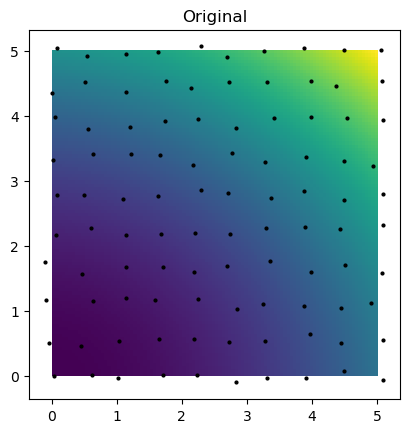
fig, axs = plt.subplots(1, 3, figsize=(9, 3))
titles = ["Original", "WarpedInterp", "CurvilinearInterp"]
grids = [function_4(grid_x, grid_y), warped_grid, curvilinear_grid]
for ax, title, grid in zip(axs.flat, titles, grids):
im = ax.imshow(grid, extent=(0, 3, 0, 3), origin="lower")
ax.set_title(title)
plt.tight_layout()
plt.show()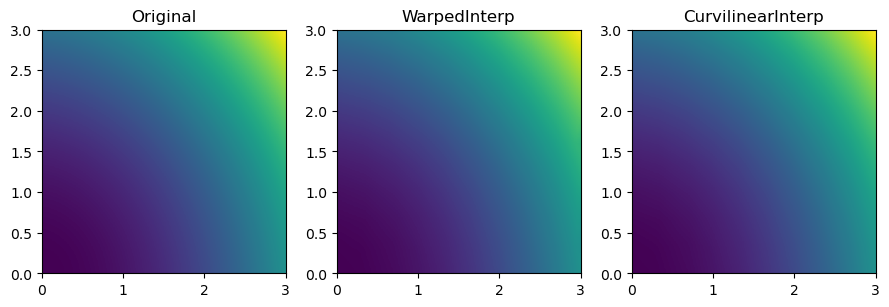
More complex functions¶
def function_5(*args):
return np.maximum(
0.0,
1.0
- np.exp(0.5 - np.prod(np.asarray(args) + 0.2, axis=0) ** (1.0 / len(args))),
)rng = np.random.default_rng(0)
warp_factor = 0.05
x_list = np.linspace(0, 1, 25)
y_list = np.linspace(0, 1, 25)
x_temp, y_temp = np.meshgrid(x_list, y_list, indexing="ij")
rand_x = x_temp + warp_factor * (rng.random((x_list.size, y_list.size)) - 0.5)
rand_y = y_temp + warp_factor * (rng.random((x_list.size, y_list.size)) - 0.5)
values = function_5(rand_x, rand_y)grid_x, grid_y = np.meshgrid(
np.linspace(0, 1, 100), np.linspace(0, 1, 100), indexing="ij"
)warped_interp = Warped2DInterp(values, (rand_x, rand_y), backend="numba")start = time()
warped_grid = warped_interp(grid_x, grid_y)
print(f"Warped interpolation took {time() - start:.5f} seconds")Warped interpolation took 0.00100 seconds
curvilinear_interp = Curvilinear2DInterp(values, rand_x, rand_y)
start = time()
curvilinear_grid = curvilinear_interp(grid_x, grid_y)
print(f"Curvilinear interpolation took {time() - start:.5f} seconds")Curvilinear interpolation took 0.02109 seconds
c:\Users\alujan\micromamba\envs\multinterp-dev\Lib\site-packages\HARK\interpolation.py:4243: RuntimeWarning: invalid value encountered in sqrt
alpha = (-eta + polarity * np.sqrt(eta**2.0 - 4.0 * zeta * theta)) / (
ax = plt.axes(projection="3d")
ax.plot_surface(
grid_x,
grid_y,
function_5(grid_x, grid_y),
rstride=1,
cstride=1,
cmap="viridis",
edgecolor="none",
)
ax.scatter(rand_x, rand_y, values, c=values, cmap="viridis", label="input points")
plt.title("Original")
plt.legend(loc="lower right")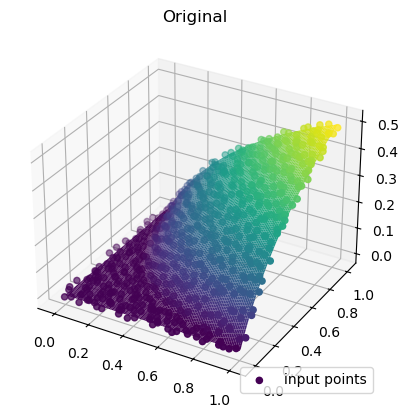
fig, axs = plt.subplots(1, 3, figsize=(9, 3), subplot_kw={"projection": "3d"})
titles = ["Original", "WarpedInterp", "CurvilinearInterp"]
grids = [function_5(grid_x, grid_y), warped_grid, curvilinear_grid]
for ax, title, grid in zip(axs.flat, titles, grids):
im = ax.plot_surface(
grid_x, grid_y, grid, rstride=1, cstride=1, cmap="viridis", edgecolor="none"
)
ax.set_title(title)
plt.tight_layout()
plt.show()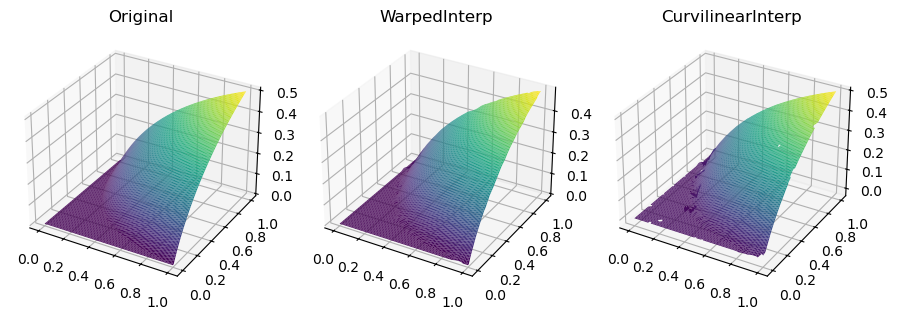
def function_6(x, y):
return 1 / (np.abs(0.5 - x**4 - y**4) + 0.1)rng = np.random.default_rng(0)
warp_factor = 0.05
x_list = np.linspace(0, 1, 25)
y_list = np.linspace(0, 1, 25)
x_temp, y_temp = np.meshgrid(x_list, y_list, indexing="ij")
rand_x = x_temp + warp_factor * (rng.random((x_list.size, y_list.size)) - 0.5)
rand_y = y_temp + warp_factor * (rng.random((x_list.size, y_list.size)) - 0.5)
values = function_6(rand_x, rand_y)grid_x, grid_y = np.meshgrid(
np.linspace(0, 1, 100), np.linspace(0, 1, 100), indexing="ij"
)warped_interp = Warped2DInterp(values, (rand_x, rand_y), backend="numba")start = time()
warped_grid = warped_interp(grid_x, grid_y)
print(f"Warped interpolation took {time() - start:.5f} seconds")Warped interpolation took 0.00202 seconds
curvilinear_interp = Curvilinear2DInterp(values, rand_x, rand_y)
start = time()
curvilinear_grid = curvilinear_interp(grid_x, grid_y)
print(f"Curvilinear interpolation took {time() - start:.5f} seconds")Curvilinear interpolation took 0.02110 seconds
ax = plt.axes(projection="3d")
ax.plot_surface(
grid_x,
grid_y,
function_6(grid_x, grid_y),
rstride=1,
cstride=1,
cmap="viridis",
edgecolor="none",
)
ax.scatter(rand_x, rand_y, values, c=values, cmap="viridis", label="input points", s=1)
ax.view_init(30, 150)
plt.title("Original")
plt.legend(loc="lower right")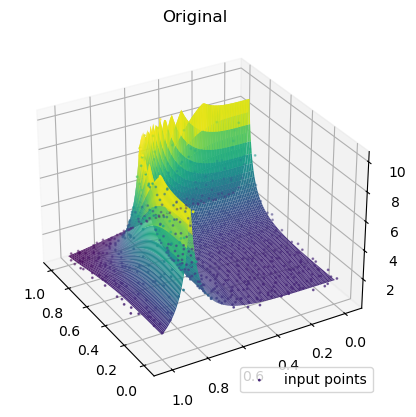
fig, axs = plt.subplots(1, 3, figsize=(9, 3), subplot_kw={"projection": "3d"})
titles = ["Original", "WarpedInterp", "CurvilinearInterp"]
grids = [function_6(grid_x, grid_y), warped_grid, curvilinear_grid]
for ax, title, grid in zip(axs.flat, titles, grids):
im = ax.plot_surface(
grid_x, grid_y, grid, rstride=1, cstride=1, cmap="viridis", edgecolor="none"
)
ax.set_title(title)
ax.view_init(30, 150)
plt.tight_layout()
plt.show()